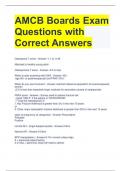AMCB Boards Exam Questions with Correct Answers Osteopenia T score - Answer --1.1 to -2.49 Matched to healthy young adult Osteoporosis T score - Answer --2.5 or less When to start screening with DXA - Answer --65+ -age 50+ or postmenopausal and FRAX 10%+ When do you use Z scores? - Answer -matched reference population for premenopausal women <2.5 is less than expected range, evaluate for secondary causes of osteoporosis FRAX score - Answer ---Survey used to assess fracture risk --Used *ONLY* if the patient is *OSTEOPENIC* --*Treat like osteoporosis if:* 1. Hip Fracture likelihood is greater than 3% in the next 10 years or 2. Other major osteopathic fracture likelihood is greater than 20% in the next 10 years signs of pregnancy (3 categories) - Answer -Presumptive Probable Positive normal AFI - single deepest pocket - Answer -2-8cm Normal AFI - Answer -5-24cm BPP interpretation - Answer -8-10= normal unless oligo 6 = equivocal,repeat testing 4 or less = abnormal, likely will need to deliver weight gain by bmi - Answer -underweight (<18.5): 28 -40lbs Normalweight: 18.5 -24.9 25 -35lbs overweight: 25.0 -29.9 15 -25lbs obese: 30+ 11 -20lbs gynecoid pelvis - Answer -round -shaped transverse slightly wider than AP 50% of white women android - Answer -heart shaped/triangular shaped posterior pelvis is wider than anterior pelvis more likely to need c/s anthropoid pelvis - Answer -oval shaped, with a wider anteroposterior diameter more likely to be OP platypelloid pelvis - Answer -pelvis that is flat in its dimensions with a very narrow anterior -posterior diameter and a wide transverse diameter; this shape makes it extremely difficult for the fetus to pass through the bony pelvis Hct - Answer -normal non pregnant: 37 -42% pregnancy:33/32/33 black women: 31/30/31 Hbg - Answer -normal non pregnancy: 12 -16 pregnancy: 11/10.5/11 black women: 10.2/9.7/10.2 wbc - Answer -5000 -10000 platelets - Answer -150,000 -400,000 Fasting glucose - Answer -Normal: 70 -99 mg/dL pre-diabetes: 100 -125 mg/dL diabetes: >125 mg/dL 2hr glucose tolerance test - Answer -normal:<140 prediabetes:140 -199 diabetes:200+ ADA diagnostic criteria for DM - Answer -1. any random glucose of 200+ 2. fasting 126+ 3. 2hr: 200+ 4. HgbA1c 6.5%+ Hgb A1c - Answer -prediabetes: 5.7 -6.4 diabetes 6.5+ good diabetic control:<7 Diagnosis of gestational diabetes - Answer -Fasting: 95 -105+ (CC v. NDDG) 1 hr: 180 -190+ 2 hr: 155 -165+ 3 hr: 140 -145+ or any BG level 200+ changes in thyroid hormones in pregnancy - Answer -TT3 and TT4 increase TSH unchanged free T4 unchanged normal vaginal pH - Answer -3.8-4.5 What may cause elevated vaginal pH - Answer -BV,trich, atrophic vaginitis,breastfeeding normal urine findings - Answer -no nitrites, ketones,crystals, casts, glucose clear, amber yellow, aromatic pH4.6 -8 protein 0 -8 specific gravity 1.005 -1.030 leukocyte esterase negative WBCs 0 -4 per high powered field RBCs 2 or less B6 and unisom - Answer -b6: 50mg BID or 25mg TID -QID doxylamine: 12.5 to 25mg PO q8 -12hrs what measurements are used for dating 2nd trimester ultrasound - Answer -head circumference, biparietal diameter, abdominal circumference and femur length Naegele's Rule - Answer -add 7 days to LMP, subtract 3 months, add 1 year Beta hcg in pregnancy - Answer -detectable 8 -11 days after conception doubles every 2 days until it peaks at 8.5 - 10 weeks gestation then rapidly declines between 12 and 16 weeks gestation. first trimester GDM screening - Answer -BMI >25 (>23 if asian) + additional risk factors like Hx GDM, 1st degree relative with DM, hx infant >4000g,PCOS,HTN, not white Hep B in pregnancy - Answer -rate of fetal transmission during birth: 90%. With hepatitis immune globulin: 3% vertical transmission is more likely if: hepatitis B surface antigen (HBsAg) positive and Hepatitis B e -antigen (HBeAg) positive Parvovirus B19 pregnancy (aka Fith's Disease) - Answer -risk of fetal transmission is 30% -50% - transmitted via droplets risk of a fetal complication from the virus is about 10% - anemia, hydrops, stillbirth The greatest risk to the fetus occurs before 20 weeks Toxoplasmosis - Answer -raw/undercooked meat; cat feces; gardening Presentation: usually asymptomatic can cause: lower IQ, hydrocephalus, chorioretinitis, deafness, SAB, prematurity, IUGR highest suspectibility in embryonic period can treat in pregnancy with MFM Varicella in pregnancy - Answer -If mother is infected between 5 days prior or 2 days after before birth, newborn needs to be given varicella -zoster immune globulin and avoid breastfeeding greatest risk for congenital varicella syndrome is infection in 1st 20 weeks presentation: fever, malaise, myalgias, HA, maculopapular rash Parvovirus B19 - Answer -Transmission: respiratory, blood manifestations: asymptomatic, mild rash & illness complications: SAB, severe fetal anemia, hydrops, stillbirth can't treat it if acquired in pregnancy Rubella - Answer -Mother's symptoms: maculopapular rash, fever, malaise, sore throat, and lymphadenopathy. transmission: Droplet/respiratory complications: SAB, stillbirth, Congenital Rubella Syndrome: IUGR, cataracts, heart defects, deafness greatest risk < 11 weeks




